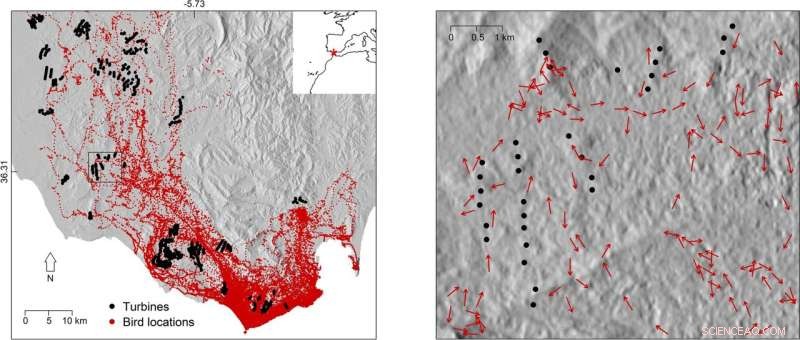Kan vindmøller og trækfugle eksistere side om side?

Venstre panel viser den rumlige fordeling af fugle- og turbineplaceringer i undersøgelsesområdet mellem Cadiz og Tarifa (det sydlige Spanien). Rød stjerne øverst til højre markerer studieområdets placering. Højre panel viser fugleflyvningsoverskrifter sammenlignet med vindmølleplaceringer i en lille del af undersøgelsesområdet (firkantet i venstre panel). Bakkeskygge blev tilføjet som baggrund for at illustrere samspillet mellem brug af fugleplads og topografi. Dataene, der blev brugt til at illustrere bakkeskygge, blev hentet fra en offentligt tilgængelig digital højdemodel (https://lpdaac.usgs.gov). Kredit:Scientific Reports (2022). DOI:10.1038/s41598-022-10295-9
I kapløbet om at undgå løbske klimaændringer bliver to vedvarende energiteknologier skubbet som løsningen på at drive menneskelige samfund:vind og sol. Men i mange år har vindmøller været på kollisionskurs med naturbeskyttelsen. Fugle og andre flyvende dyr risikerer død ved påvirkning af rotorbladene på møller, hvilket rejser spørgsmål om gennemførligheden af vind som en hjørnesten i en global ren energipolitik. Nu har et par dyresporingsstudier fra Max Planck Institute of Animal Behavior og University of East Anglia, UK, leveret detaljerede GPS-data om flyveadfærd for fugle, der er modtagelige for kollision med energiinfrastruktur. Den første, en storstilet undersøgelse af 1.454 fugle fra 27 arter, har identificeret hotspots i Europa, hvor fugle er særligt udsatte fra vindmøller og elledninger. Den anden zoomede ind på, hvordan fugle opfører sig, når de flyver nær turbiner, og afslørede, at individer aktivt vil undgå turbiner, hvis de er inden for en kilometer. Ved at spore fugles bevægelser med GPS-enheder med høj præcision giver begge undersøgelser de detaljerede biologiske data, der er nødvendige for at udvide infrastrukturen for vedvarende energi med minimal påvirkning af dyrelivet.
Vindenergiproduktionen er steget i løbet af de sidste to årtier med den globale forpligtelse til overgang til vedvarende energi fra kulstofemitterende fossile brændstoffer. Europæisk vindenergikapacitet på land forventes at vokse næsten firedoblet i 2050, og lande i Mellemøsten og Nordafrika, såsom Marokko og Tunesien, har også mål om at øge andelen af elforsyning fra landvind.
"We know from previous research that there are many more suitable locations to build wind turbines than we need in order to meet our clean energy targets up to 2050," said lead author Jethro Gauld, a Ph.D. researcher in the School of Environmental Sciences at University of East Anglia. "If we can do a better job of assessing risks to biodiversity, such as collision risk for birds, into the planning process at an early stage we can help limit the impact of these developments on wildlife while still achieving our climate targets."
Pinpointing collision hotspots in Europe
An international team of 51 researchers from 15 countries, including the Max Planck Institute of Animal Behavior in Germany, collaborated to identify the areas where these birds would be more sensitive to onshore wind turbine or power line development. The study, published in Journal of Applied Ecology , used GPS location data from 65 bird tracking studies to understand where they fly more frequently at danger height—defined as 10 to 60 meters above ground for power lines and 15 to 135 meters for wind turbines. "GPS tracking provides very accurate data on location and flight height, which cannot be obtained from direct observation, particularly from large distances," says Martin Wikelski, director at the Max Planck Institute of Animal Behavior and co-author on the study. "This study represents the first time GPS data from so many species has been pooled to create a comprehensive picture of where birds are at risk.
The resulting vulnerability maps reveal that the collision hotspots are particularly concentrated within important migration routes, along coastlines and near breeding locations. These include the Western Mediterranean coast of France, Southern Spain and the Moroccan Coast—such as around the Strait of Gibraltar—Eastern Romania, the Sinai Peninsula and the Baltic coast of Germany. The GPS data collected related to 1,454 birds from 27 species, mostly large soaring ones such as white storks. Exposure to risk varied across the species, with the Eurasian spoonbill, European eagle owl, whooper swan, Iberian imperial eagle and white stork among those flying consistently at heights where they risk collision. The authors say development of new wind turbines and transmission power lines should be minimized in these high sensitivity areas, and any developments which do occur will likely need to be accompanied by measures to reduce the risk to birds.
How birds behave near turbines
As well as providing location and flight height, GPS loggers open up an additional frontier in efforts to better plan energy infrastructure. "With GPS tracking we are able to understand exactly how birds behave as they fly close to the turbines," says Carlos Santos, an Affiliated Scientist of the Max Planck Institute of Animal Behavior and an Assistant Professor at the Federal University of Pará, in Brazil. "Knowing how close they fly, and whether or not wind or other factors influence their flight behavior, is very important to mitigate collision rates as it can help better planning of wind farms."
A team of scientists from the Max Planck Institute of Animal Behavior and the University of East Anglia focused their attention on the black kite, a very common soaring bird that migrates through the Strait of Gibraltar, the narrow straight between southern Spain and North Africa. "The Strait of Gibraltar is the main migratory bottleneck for birds in western Europe but it's also a hotspot for wind farms," says Santos. "We wanted to see how soaring birds behave in this area, which represent a serious threat during their migration to Africa."
This study, published in Scientific Reports , looked at GPS information from 126 black kites as the birds approached wind turbines. The data showed that birds avoided flight paths straight to turbines as they flew closer to them. The birds started to deviate from turbines one kilometer away, but this effect was even more pronounced within 750 meters and when the wind was blowing towards the turbines. "This means that they recognize the risk of the turbines and keep a safe distance from them," says Santos.
The authors say collecting GPS data from the interaction between birds and turbines is extremely difficult. Says Santos:"You need to tag many animals to increase the chances of recording their behavior near the turbines. This is why our dataset is so uncommon. Fortunately, GPS tracking studies are becoming more common and hopefully in the near future we will be able to gather data of this sort for other soaring bird species." The authors stress that understanding how the birds perceive wind turbines and which factors attenuate or exacerbate their perception is critical to learn where to place turbines and to develop effective deterrents.
 Varme artikler
Varme artikler
-
 Korrekt brugt neonik påvirker ikke honningbikolonier negativt, nye forskningsfundKredit:CC0 Public Domain De tre mest udbredte neonikotinoide pesticider til blomstrende afgrøder udgør ingen risiko for honningbikolonier, når de bruges korrekt som frøbehandling, ifølge nye under
Korrekt brugt neonik påvirker ikke honningbikolonier negativt, nye forskningsfundKredit:CC0 Public Domain De tre mest udbredte neonikotinoide pesticider til blomstrende afgrøder udgør ingen risiko for honningbikolonier, når de bruges korrekt som frøbehandling, ifølge nye under -
 Hvordan ved planter, hvor store de skal vokse?Et konfokalt billede af at udvikle Arabidopsis-blade udlånt af Flavia Bossi. Kredit:Carnegie Institution for Science Organismer vokser, så de passer til den plads og de tilgængelige ressourcer i de
Hvordan ved planter, hvor store de skal vokse?Et konfokalt billede af at udvikle Arabidopsis-blade udlånt af Flavia Bossi. Kredit:Carnegie Institution for Science Organismer vokser, så de passer til den plads og de tilgængelige ressourcer i de -
 Kinesiske fossile æg viser dinosaurernes tilbagegang før udryddelseKunstnerens skildring af oviraptorosaurer, hadrosaurer og tyrannosaurer fra sen kridt, der bor i det centrale Kina. Kredit:IVPP For næsten 66 millioner år siden ramte en stor asteroide Jorden og bi
Kinesiske fossile æg viser dinosaurernes tilbagegang før udryddelseKunstnerens skildring af oviraptorosaurer, hadrosaurer og tyrannosaurer fra sen kridt, der bor i det centrale Kina. Kredit:IVPP For næsten 66 millioner år siden ramte en stor asteroide Jorden og bi -
 Hvordan dinosaurudryddelsen ændrede planteudviklingenKredit:Pixabay/CC0 Public Domain Med udryddelsen af store, ikke-flyvende dinosaurer for 66 millioner år siden, manglede store planteædere på Jorden i de efterfølgende 25 millioner år. Da planter
Hvordan dinosaurudryddelsen ændrede planteudviklingenKredit:Pixabay/CC0 Public Domain Med udryddelsen af store, ikke-flyvende dinosaurer for 66 millioner år siden, manglede store planteædere på Jorden i de efterfølgende 25 millioner år. Da planter
- Tornadoer river gennem Tennessee, 25 døde
- Livsstilsmigranter bringer gode hensigter – men store forandringer – til Costa Rica
- Mangan-enkeltatom-katalysator øger ydeevnen af elektrokemisk reduktion af kuldioxid
- Undersøgelse tyder på kvindelig fordel i forventet levetid relateret til grundlæggende biologiske…
- Ny probe for stofskiftesygdomme
- Forskere forbinder gammel træstruktur med vandritualer


